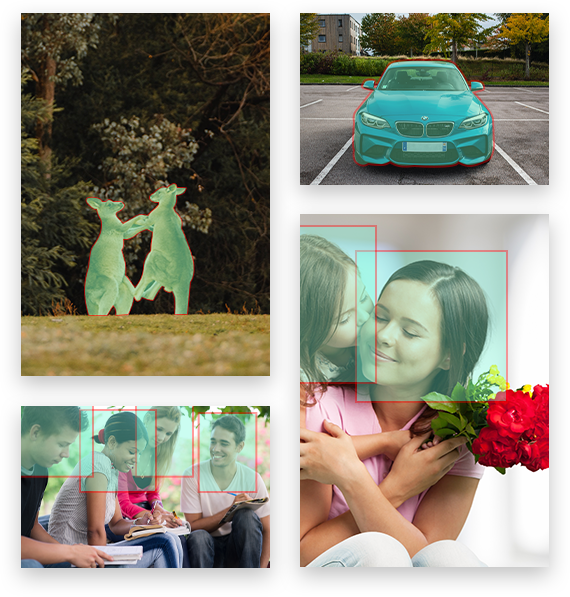One of the most crucial processes in Computer Vision (CV), AI image annotation serves as the foundation for many Artificial Intelligence (AI) products you use. In image annotation, data labelers use metadata or tags to specify the details of the data that you want your AI model to learn to recognize. The tagged images are then utilized for computer training to identify the characteristics when presented with new, unlabeled data.
Computers learn how to classify things by looking at many examples, just like humans do. These examples are given understandably for the computer by image annotation. The number of projects relying on image annotation has increased exponentially as companies pursuing AI have access to more and more image data. For businesses engaged in this branch of machine learning (ML), developing an extensive, effective image annotation process has become increasingly important.
Common Techniques Used in Image Annotation
The Chief techniques used in image annotation include the following:
Landmarking
Landmarking is a vital technique for recognizing gestures, facial features, emotions, and facial expressions. Additionally, it is used to indicate the orientation and position of the body. For instance, for face identification, data labelers assign numerical values to specific areas of the face, such as the lips, eyes, forehead, brows, and so forth. Using this information, an ML model can be trained to recognize these areas.
Bounding Box
In the Bounding Box technique, a frame is drawn around the object that needs to be identified. The technique can be used for both 2-D and 3-D images.
Polygon
This technique is utilized for marking the pick point of the target object and framing its edges. The Polygon technique is beneficial for labeling objects that have irregular shapes.
Masking
Masking includes pixel-level annotations that cover some parts of an image and draw attention to other parts that need to be seen. Consider this method as an image filter that facilitates focusing on particular regions of the image.
Polyline
The polyline method aids in building machine learning (ML) models for computer vision that direct autonomous vehicles. It guarantees that ML models perceive the environment for safe driving by identifying objects on the road, directions, turns, and oncoming traffic.
Polygon
The pick point and edges of the target object are marked and framed using this technique. Labeling objects with asymmetrical shapes can be done effectively using the Polygon technique.
Significance of Image Annotation in Augmented Reality and Virtual Reality Applications
By providing the necessary details and context for the virtual experiences or objects, image annotation services play a vital role in augmented reality (AR) and virtual reality (VR) applications. Following are some important ways in which image annotation benefits AR and VR applications:
Environmental Mapping
Image annotation aids in the creation of precise 3-D maps or models of the actual environment for use in AR and VR applications. For virtual objects to align correctly and interact with their surroundings realistically, annotated images can be used to provide details about the configuration, characteristics, and dimensions of actual objects.
Semantic Segmentation
Image annotation may involve dividing an image into sections that represent various objects or elements. For AR and VR applications, this semantic segmentation is useful because it allows for precise interaction with and manipulation of virtual objects in the scene. The system can apply the relevant visual effects or physics-based simulations by understanding the boundaries and characteristics of different regions.
Object Recognition and Tracking
Image annotation plays a key role in training computer vision algorithms to recognize and track real-world objects in AR and VR environments. With the help of annotation using bounding boxes or labels, the system can accurately identify and track the objects, empowering virtual objects to be placed and interacted with in the real world.
Contextual Information
Image annotation can provide details about specific objects or scenes in AR and VR applications. For the system to provide pertinent information or interactions based on the user’s context, annotations may include descriptions, attributes, or other object-related metadata.
Pose and Gesture Recognition
Annotated images can be utilized for training algorithms to identify body poses or hand gestures in AR and VR applications. The system can precisely track and interpret user movements by marking key locations or joint positions on images or video frames. This enables natural interaction with virtual objects.
Conclusion
Overall, image annotation is essential to AR and VR applications because it enables object recognition, environmental mapping, gesture recognition, semantic segmentation, and contextual information. AR and VR systems can improve user interaction, create more immersive virtual environments, and enhance the user experience by annotating images with useful labels, bounding boxes, or key points.
Image annotation techniques call for some manual labor. Organizations must make a critical strategic choice regarding who should carry out this manual task. The primary approaches—in-house and outsourcing—offer various degrees of cost, output quality, data security, etc. There is no particular strategy for selecting between these two methods. It all depends on the conditions and needs of your organization.
However, image annotation outsourcing can be a useful tool for improving the accuracy of your results as well as the efficiency of your workflow. An external team of annotators also provides the best value in terms of cost savings. Outsourcing carries some inherent risks, but the benefits are undeniable and far outweigh the risks. Outsourcing image annotation is the best option to process your visual data quickly and accurately.
Click here to know more about the original post: https://www.techsling.com/the-role-of-image-annotation-in-augmented-reality-and-virtual-reality-applications/






